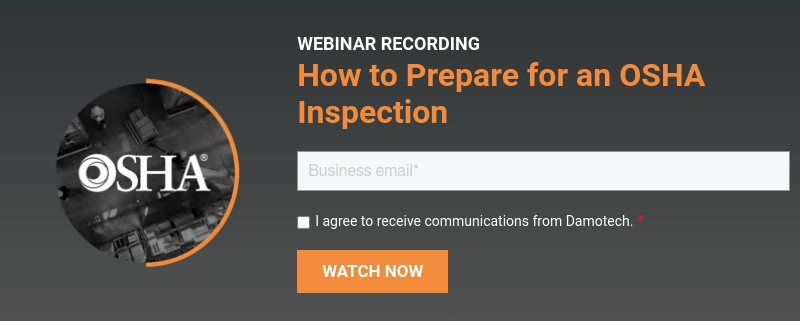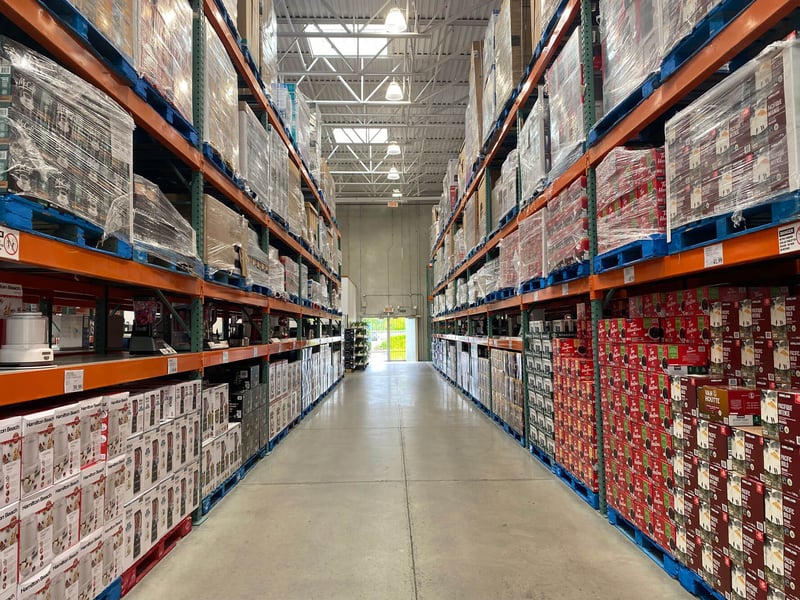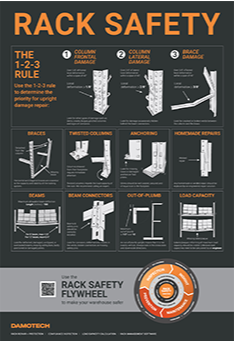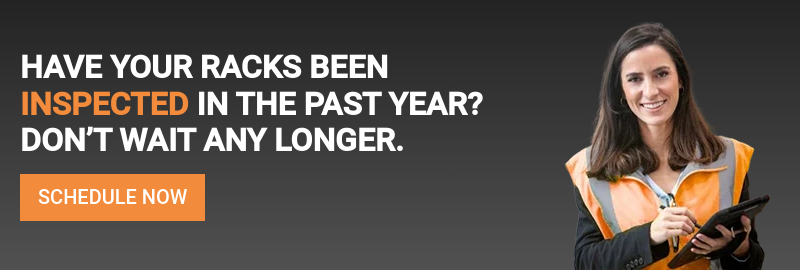Warehousing and distribution centers have experienced remarkable growth in the last decade, employing over 1.9 million people in the United States alone. However, this growth has increased workplace injury and illness rates: the average in warehousing and distribution centers is higher than the private general industry’s, with some sectors experiencing double the injury rate of the overall general industry.
To address these concerns, the U.S. Department of Labor’s Occupational Safety and Health Administration (OSHA) has introduced a National Emphasis Program (NEP). OSHA’s new program goes beyond just reducing workplace injuries; it aims to enhance employees’ health and safety.
Is your warehouse ready for an inspection under OSHA’s NEP? This blog will delve into the essential components of OSHA’s new NEP and its potential impact on employers and their pallet rack safety programs. Discover steps you can take to proactively prepare for upcoming changes and ensure workplace safety.
Safety and health challenges in warehousing and distribution centers
The decision to introduce a new NEP with a specific focus on “Warehousing and Distribution Operations” underlines the gravity of the situation in this industry.
Between 2011 and 2021, the warehousing and distribution center industry saw employment numbers skyrocket from 668,900 to 1,713,900 (seasonally adjusted), but it also experienced heightened rates of occupational injuries and illnesses.
For instance, from 2017 to 2021, data reveals that workers in warehousing and distribution faced higher rates of nonfatal occupational injuries and illnesses than the average rate across all private industries, even that of the construction industry.
| Industry | North American Industry Classification System (NAICS) Code | Total Recordable Cases Rates |
| All private industry | 2.76 | |
| General warehousing & storage | 493110 | 5.18 |
| Refrigerated Warehousing and Storage | 493120 | 5.16 |
| Other Warehousing and Storage | 493190 | 2.86 |
OSHA’s enhanced oversight and safety measures for high-risk retail establishments
Many retail establishments share similar hazards with warehousing and distribution facilities, especially in loading and storage areas, where injuries often occur. OSHA’s NEP program outlines procedures for conducting focused inspections in specific retail establishments with the highest rates of injuries and illnesses.
This NEP focuses on the following highest-risk retail establishments, identified through the latest employer-reported data from 2021:
- Home centers
- Hardware stores
- Other building material dealers
- Supermarkets and other grocery (except convenience) stores
- Warehouse clubs and supercenters
During inspections, OSHA will concentrate on the loading and storage areas. They could potentially broaden the scope of their inspection if evidence (such as injuries or illnesses documented, employee statements, or observations) suggests that violations may be present in other areas of the establishment.
Key focus areas of OSHA’s NEP
OSHA’s main objective is to improve safety in warehousing and distribution centers by:
- Reducing workplace hazards.
- Preventing accidents.
- Ensuring the health and safety of workers.
Assistant Secretary for Occupational Safety and Health, Doug Parker, underlines that, with OSHA’s warehousing NEP, their “enforcement efforts are designed to do one thing: lead to permanent change in workplace safety.”
OSHA’s NEP will span three years and involve comprehensive safety inspections that focus on various common hazards workers face in warehouses and distribution centers. Workplaces covered by the NEP should pay particular attention to the following areas of concern:
Powered industrial vehicle operations: OSHA will conduct inspections of powered industrial truck operations, such as forklifts, to ensure safe and proper usage. To prevent accidents, the goal is to ensure that forklifts are operated and maintained correctly.
Material handling and storage: Potential hazards related to the handling and storing of materials will be examined to identify and address any risks. It includes ensuring safe material handling and storage practices to prevent accidents and injuries.
Special attention will be given to the proper storage and handling of hazardous chemicals to minimize the risks of exposure.
Walking and working surfaces: The safety of walking and working surfaces will be assessed to reduce the likelihood of slips, trips, and falls.
Means of egress and fire protection: OSHA will verify the presence of secure exit routes for employees and assess the effectiveness of fire safety measures, such as fire extinguishers, to protect them during emergencies. The agency will also examine the facility’s emergency preparedness plan and the efficiency of its evacuation procedures.
Heat: OSHA will evaluate the risk of heat-related illnesses and conduct health inspections if necessary. The agency may review injury and illness records, conduct worker interviews, perform establishment walkthroughs, and verify if measures have been implemented to protect workers from occupational heat exposure.
This includes ensuring adequate warehouse ventilation, such as the use of fans, and facilitating proper hydration by providing access to water and allowing water breaks.
When an establishment falls under OSHA’s warehousing NEP and the program related to outdoor and indoor heat-related hazards, safety and health inspections may be carried out concurrently under both programs.
Ergonomic hazards: Ergonomic injuries can result, for example, from repetitive tasks and improper lifting techniques. OSHA will evaluate worker exposure to ergonomic hazards. If ergonomic hazards are identified, the inspection will encompass these concerns and a health inspection will be initiated.
What does OSHA’s NEP mean for employers in the warehousing and distribution industry?
OSHA’s NEP represents a significant shift in the approach to workplace safety in the warehousing and distribution industry. The program aims to reduce and prevent workplace hazards and encompasses all employees, including full-time, part-time, permanent, temporary, seasonal, and contract workers.
OSHA will select establishments for inspection based on two key lists:
- The first includes establishments falling within the NEP’s designated industry codes.
- The second list features a group of retail establishments with the highest injury and illness rates, leading to days away from work, restricted duties, or job transfers.
The program sets itself apart from routine OSHA inspections, and will impact the industry:
Comprehensive inspections: With the NEP in place, OSHA allocates more resources to conduct frequent and complete inspections within the industry. This heightened focus guarantees a thorough examination of workplace safety.
Expect more comprehensive, “wall-to-wall” inspections rather than partial checks.
Emphasis on specific hazards: The NEP is meticulously crafted to target hazards identified by OSHA as high-risk in the warehousing industry. The primary aim is to enhance safety measures and compliance in these areas, thereby reducing potential risks.
Enhanced outreach and training: OSHA will provide additional guidance, outreach programs, meetings, publications, and training to employers and employees operating within the scope of the NEP to raise awareness. This educational initiative empowers them to understand and address the specific hazards in focus.
Higher penalties for non-compliance: OSHA officers will review the establishment’s injury and illness records for compliance. Violations related to the hazards in the industry targeted by the NEP may result in more substantial fines and penalties compared to regular inspections. It serves as a strong incentive for organizations to prioritize safety.
Potential regulatory changes: Implementing the NEP may result in changes to regulations or standards. It happens as new risks or issues are identified, prompting the need for updated guidelines to ensure a safe work environment.

How do you prepare for an inspection under OSHA’s NEP?
Considering OSHA’s heightened focus on inspections in the warehousing and distribution industry, it’s vital for companies to be prepared.
Since inspections under the program have already begun in October 2023, employers should take proactive steps to prepare for these upcoming changes and ensure workplace safety:
- Implement safety measures: Display signs and visible cues that promote injury prevention and safety. For instance, you could hang a warehouse safety poster to help ensure that rack safety remains top-of-mind for everyone in the warehouse. You could also put up aisle ownership signs at the end of your warehouse aisles. Warehouse employees can be responsible for keeping their assigned aisle in good condition, including the overall cleanliness, pallet racks, and pallets.
- Provide training to your employees: Educate safety personnel, managers, and employees on responding if OSHA conducts an inspection. Ensure that your employees are also trained on pallet rack safety and know what steps to follow when facing rack safety concerns.
- Maintain updated written policies: Ensure your documented training and maintenance policies are current.
- Keep documentation up to date: Maintain current and accurate documentation, including rack load capacities and records of injuries, training, and pallet rack inspections. Consider using rack inspection software to better manage the maintenance of your racking assets with less effort.
- Continuously plan for safety: Demonstrate ongoing safety maintenance and planning within your workplace and promote a safety culture. Additionally, conduct a review of your safety and health programs to ensure they align with OSHA’s standards and effectively address common hazards.
- Heat-related hazards: With record-breaking heat observed in the summer of 2023, reassess your indoor and outdoor heat-related risks. Ensure that employees are well-trained to recognize heat-related illnesses in themselves and their coworkers.
- Conduct hazard assessment: Perform a hazard assessment focusing on powered industrial vehicle operations, material handling, storage, walking and working surfaces, means of egress, and fire protection. Additionally, make sure to schedule an inspection of potential hazards associated with industrial racking.
- Retail establishments: Retail employers should conduct similar hazard assessments, especially in back-of-house operations related to storage and loading areas.
Conclusion: Navigating OSHA’s National Emphasis Program
OSHA's new NEP shows a strong commitment to enhancing worker safety and lowering workplace injuries. OSHA acknowledges the growing warehousing sector and aims to address safety issues, improve operational procedures, and introduce safety upgrades. It could mean more inspections and possible citations with penalties.
For pallet rack safety, you should focus on your current procedures, review practices, and identify any gaps. Prioritize compliance with safety rules and take proactive steps to address hazards, keeping your workplace safe and avoiding OSHA attention.
However, tackling this process alone can be difficult. If you’re unsure where to start, seek the help of rack safety experts. They can handle rack safety concerns for you, allowing you to concentrate on other critical operational tasks. By proactively engaging in safety program reviews, employee training, and hazard assessments, combined with expert guidance, you can create a safer and healthier workplace while maintaining a positive relationship with OSHA.















